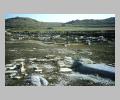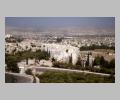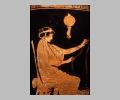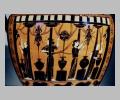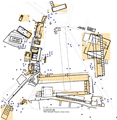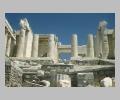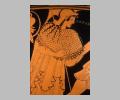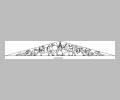Athenian Empire in the Golden Age
The struggle against the Persian invasion had occasioned a rare interval of inter-state
cooperation in ancient Greek history. The two most powerful city-states,
Athens and
Sparta, had put aside their mutual suspicions stemming from their clash at
the time of
Cleisthenes' reforms1 in order to share the leadership of the
united Greek military forces. Their attempt to continue this cooperation after the repulse
of the Persians, however, ended in failure. Out of this failure arose the so-called
Athenian Empire, a modern label invented to point out the political and economic dominance
Athens came to exercise over other Greek states in an alliance originally set up as a
voluntary association of its members against Persia.
The Establishment of an Athenian Empire
The victorious Greeks decided in 478 B.C. to continue a naval alliance in order to
attack the Persian outposts that still existed in far northern Greece and western
Anatolia, especially Ionia. The Spartans naturally assumed leadership of this alliance,
continuing the position that they had held at the had of the Greek coalition formed to
resist the invasion of Xerxes. The
conduct of the Spartan commander,
Pausanias2, soon caused disaffection among the Greek allies,
however, and Athens soon took over the position of hegemon (leader by consensus) of the
alliance. This change in leadership marked the beginning of the establishment of what
would become an Athenian Empire.
The Misconduct of Pausanias the Spartan
The Spartan Pausanias, victor of the battle of Plataea, was chosen to lead the first
expedition of the naval alliance against the remaining Persian outposts in Greek
territory.
His arrogant and violent behavior3, especially toward women, quickly led to dissatisfaction with
Spartan leadership among the Greek allies. This kind of outrageous conduct was to
prove common in the future for Spartan men in positions of power when away from home.
Their regimented training in Sparta apparently left them ill prepared to operate
humanely and effectively once they had escaped from the constraints imposed by their
austere way of life as “
Equals4”, as Spartan adult male citizens were called, always
under scrutiny by one another in their homeland. Spartan kings, too, who grew up under
a freer regimen than did ordinary Spartan men, tended to lose sight of the Spartan
tradition of austerity and just behavior when they campaigned abroad for long periods.
Not even they were immune to the corrupting influence of the desire for luxury, which
the austere life of Spartans at home in Sparta excluded as a matter of principle and
law.
Spartan Approval of Athenian Leadership
By 477 B.C., the Athenian aristocrat
Aristides5 (c. 525-465 B.C.) had successfully
persuaded the other Greeks to request
Athenian leadership6 of the continuing naval alliance against the Persians. The
leaders at
Sparta were happy to cede their position7 at the head of the alliance because, in the words of the Athenian historian
Thucydides (c. 460-400 B.C.),
“they were afraid any other commanders
they sent abroad would be corrupted, as Pausanias had been, and they were glad to be
relieved of the burden of fighting the Persians.... Besides, at the time they still
thought of the Athenians as friendly allies.”8 It could be added that Sparta's ongoing need to keep its army at home most of
the time to
guard against helot revolts9 also made prolonged overseas
operations difficult to maintain.
A Permanent Structure for the Alliance
Under Athenian direction, the
Greek alliance against Persia took on a permanent
organizational structure10. Member states
swore a solemn oath never to desert the coalition. The members were predominately
located in northern Greece, on the islands of the Aegean Sea, and along the western
coast of Anatolia—that is, in the areas most exposed to Persian attack. Most
of the independent city-states of the Peloponnese, on the other hand, remained in
their traditional alliance with the Spartans. This alliance of Sparta and its allies,
which modern historians refer to as the Peloponnesian League, had an assembly to set
policy, but no action could be taken unless the Spartan leaders agreed to it. The
alliance headed by Athens also had an assembly of representatives to make policy.
Its structure was supposed to allow participation by all its
members.11
The Finances of the Alliance (Delian League)
The Athenian representatives came to dominate this erstwhile democracy, however, as a
result of the special arrangements made to finance the alliance's naval operations.
Aristides set the different levels of payments12 the various member states were to pay each year, based on their
size and prosperity. The Greek word describing the payments was
phoros
13, literally “that which is brought.” Modern historians
refer to the payments as “tribute,” but the translation
“dues” might come closer to the official terminology of the
alliance, so long as it is remembered that these dues were compulsory and permanent.
For their tribute payments,
larger member states were assessed the
responsibility of supplying entire warships14 complete with crews and pay; smaller states could share the
cost of a ship, or simply contribute cash which would be put together with others'
payments to pay for ships and crews. Over time, more and more of the members of the
alliance chose to pay their dues in cash rather than go to the trouble of furnishing
warships. The alliance's
funds were kept on the centrally-located island of
Delos15, in the group of islands in the Aegean Sea called the
Cyclades16, where they were placed under the guardianship of the god Apollo, to whom the
whole island of Delos was sacred. Historians today refer to the alliance as the Delian
League because its treasury was originally located on Delos.
The Warships of the Delian League
The warship of the time was a narrow vessel built for speed called a
trireme17(“triple-banks-of-oars ship”), a name
derived from its having three tiers of oarsmen on each side for propulsion in
battle. One hundred and eighty rowers were needed to propel a trireme, which fought
mainly by ramming enemy ships with a metal-clad ram attached to the bow and thus
sinking them bypuncturing their hulls below the water line. Triremes also carried a
complement of about twenty officers and marines; the marines, armed as infantry,
could board enemy ships. Effective battle tactics in triremes required extensive
training and physical conditioning of the crews.
Most member states of the
Delian League preferred to pay their annual dues in cash instead of furnishing
triremes18 because
it was beyond their capacities to build ships as specialized as triremes and to
train crews in the intricate teamwork required to work triple banks of oars in
battle maneuvers. Athens was far richer and more populous than most of its allies in
the Delian League, and it not only had the shipyards and craftsmen to build triremes
in numbers but also a large pool of poorer men eager to earn pay as rowers.
Therefore, Athens built and manned most of the alliance's triremes, using the dues
of allies to supplement its own contribution.
The Rebellion of Thasos
Since Athens supplied the largest number of warships in the fleet of the Delian
League, the
balance of power in the League came firmly into the hands of the
Athenian assembly,19 whose members decided how Athenian ships were to be employed. Members of the
League had no effective recourse if they disagreed with decisions made for the League
as a whole under Athenian leadership. Athens, for instance, could compel the League to
send its ships to force reluctant allies to go on paying dues if they stopped making
their annual payments. The most egregious instance of such compulsion was the
case of the city-state of the island of Thasos20 which,
in 465 B.C, unilaterally withdrew from the Delian League after a dispute with Athens
over gold mines on the neighboring mainland. To compel the Thasians to keep their
sworn agreement to stay in the League, the Athenians led the fleet of the Delian
League, including ships from other member states, against Thasos. The attack turned
into a protracted siege, which finally ended after three years' campaigns in 463 B.C.
with the island's surrender. As punishment, the League forced Thasos to pull down its
defensive walls, give up its navy, and pay enormous dues and fines. As Thucydides
observed, rebellious allies like the Thasians “lost their
independence,” making the Athenians as the League's leaders
“no longer as popular as they used to be.”21
The Military and Financial Success of the Delian League
The Athenian-dominated Delian League enjoyed
success after success against the
Persians in the 470s and 460s.22 Within
twenty years after the rout of the Persian fleet in the battle of Salamis in 479,
almost all Persian garrisons had been expelled from the Greek world and the Persian
fleet driven from the Aegean. Although the Persian heartland was not threatened by
these setbacks, Persia ceased to be a threat to Greeks for the next fifty years.
Athens meanwhile grew stronger from its share of the spoils captured from Persian
outposts and the dues paid by its members. By the middle of the fifth century B.C.,
League members' dues alone totaled an amount equivalent to perhaps $200,000,000 in
contemporary terms (based on the assumption of $80 as the average daily pay of a
worker today). For a state the size of Athens (around 30,000 to 40,000 adult male
citizens at the time), this annual income meant prosperity.
Athenian Self-Interest in Empire
The male citizens meeting in the assembly23 decided how to spend the city-state's
income. Rich and poor alike had a self-interest in keeping the the fleet active and
the allies paying for it. Well-heeled aristocrats like
Cimon24 (c. 510-450 B.C.), the son of
Miltiades the victor of the battle of
Marathon,25 could enhance their social status by commanding successful League campaigns
and then spending their share of the spoils on benefactions to Athens. The numerous
Athenian men of lesser means
who rowed the Delian League's ships26 came to depend on the income they earned on League expeditions. The
allies were given no choice but to acquiesce to Athenian wishes on League
policy.27 The men of Athens insisted on freedom for themselves, but they failed to
preserve it for the member states in the alliance that had been born in the fight for
just this sort of freedom from domination by others. In this way, alliance was
transformed into empire, despite Athenian support of democractic governments in some
allied city-states previously ruled by oligarchies. From the Athenian point of view,
this transformation was justified because, by keeping the allies in line, the alliance
remained strong enough to do its job of protecting Greece from the Persians.
The Democratic Reform of the Athenian System of Justice
Since poorer men powered Athens' fleet as rowers and since Athenian empire rested on
naval power, the military and political importance of poorer men grew at Athens in the
decades following the Persian Wars. As these poorer citizens came to recognize that they
provided the foundation of Athenian security and prosperity, they evidently felt the
time had come to make the
administration of justice28 at Athens just as democratic as the process of making policy and passing laws in
the
assembly,29 which was open to all male citizens over eighteen years old.
Equally democratic in its selection was the membership of the
council30
of 500 (boule), which prepared the assembly's agenda
and performed other public business including some judicial functions. The council was
filled each year by drawing lots to select the year's membership in the council from
among male citizens over thirty years of age. The use of the lot was felt to be
democratic because it gave an equal chance to all eligible men to be selected for
government office. Although at this time the assembly could serve as a court of appeals,
most judicial verdicts were rendered by the city-state's
nine annual
magistrates31 (archons) and the
Areopagus32 council of ex-magistrates. The nine
annual magistrates, officials who saw to much of the adminstration of the city-state,
had been chosen by lot rather than by election since 487 B.C. The use of the lot made
access to those offices a matter of random and therefore democratic chance rather than
liable to domination by wealthy aristocrats, who could afford major electoral campaigns.
But even democratically selected magistrates were susceptible to corruption, as were the
members of the Areopagus. A different judicial system was needed if those men who
decided cases were to be insulated from pressure by socially prominent people and from
bribery by those rich enough to buy a favorable verdict. That laws were enacted by
democratically constituted bodies meant little if those same laws were not applied
fairly and honestly.
Helot Revolt at Sparta
The pressure to reform the judicial system reached the boiling point when a crisis in
foreign affairs heated up Athenian politics. The crisis began in 465 B.C. with a
tremendous earthquake in Laconia, the territory of the Spartans in the Peloponnese. It
killed so many Spartans that the
helots in Messenia instigated a massive
revolt.33Messenia34 was the large region of the
Peloponnesus bordering Spartan territory on the west, which the Spartans had conquered
in the eighth and seventh centuries and whose formerly free inhabitants they had
enslaved as helots to farm the land for the benefit of the Spartans. By 462 B.C. the
revolt had become so serious that the Spartans, swallowing their considerable pride,
appealed to Athens for military help, despite the chill that had fallen over relations
between Athens and Sparta since the days of their cooperation against the Persians.
The tension between the former allies was caused by rebellious members of the Delian
League like the Thasians,
who had received at least moral support from the
leaders at Sparta.35 Spartan leaders apparently felt that Athens, as the head of the Delian League,
was growing powerful enough someday to threaten Spartan interests in the Peloponnese.
Cimon, the hero of the Delian League's campaigns, marshalled all his prestige to
persuade a reluctant Athenian assembly to send hoplites to help the Spartans in 462
B.C. Cimon, like many Athenian aristocrats, had always admired the Spartans, and he
was renowned for registering his opposition to proposals in the assembly by saying,
“But that is not what the Spartans would do.”36 (This quotation is attributed to the fifth-century author Stesimbrotus) His
Spartan friends let him down, however, by soon changing their minds and sending him
and his army home. The Spartans feared that the democratically inclined Athenian
soldiers might decide to help the helots (who were fellow Greeks) escape from Spartan
domination.
The Reforms of Ephialtes
The
humiliating rejection by Sparta of their help outraged the men of
Athens37 and provoked hostile relations
between the two states. The disgrace the rejection brought to Cimon carried over to
his fellow aristocrats in general, thereby establishing a political climate ripe for
further democratic reforms. An Athenian named
Ephialtes promptly seized the
moment in 461 B.C.38 and convinced the assembly to pass measures limiting the power
of the
Areopagus.39 More
importantly, his reforms set up a
judicial system of courts40 manned by male citizens over thirty years old chosen by lot
for each case. The reforms made it virtually impossible to influence or bribe the
citizen jurors because 1) all trials were concluded in one day, and 2) juries were
large (from several hundred to several thousand). There was no judge to instruct the
jurors, nor any lawyers to harangue them—only an official to keep fights
from breaking out. Jurors made up their own minds after hearing speeches made by the
plaintiffs and defendants, who spoke on their own behalf and sometimes called their
friends and supporters to do so. The accuser and the accused, although they were
required to speak for themselves, might pay someone else to compose their speech to
the court, which they then delivered as if it consisted of their own words. A majority
vote of the jurors ruled, and there was no appeal from the decision of the court.
Athenian Radical Democracy
The structure of the new court system reflected the underlying principles of what
scholars today call the “radical” democracy of Athens in the
Golden Age of the mid-fifth century B.C. In that system, candidates for the office of
general41 (strategos) and a few other offices competed
in elections for their annual offices because their posts required special
competencies. Most
posts in Athenian government, however, were filled by
lot42 from among the adult male citizen body. All adult male citizens could attend
the
assembly43, which met
in regular session about forty times a year, to propose, discuss, and vote on
legislation. The egalitarian nature of Athenian radical democracy depended on a set of
principles, which was not without its own internal tensions: 1) wide-spread
participation by a cross-section of male citizens in government and the administration
of justice, 2) selection of participants at random for most public offices, 3)
elaborate precautions to prevent corruption and strict procedures for reviewing the
performance in office of officials, 4) equal protection under the law for citizens
regardless of wealth, 5) some legal restrictions on citizen women, 6) privilege being
given to the interest of the majority when that interest was in conflict with the
interest of any minority or individual, while maintaining at the same time 7) a firm
respect for the freedom of the individual.
Ostracism
The potential conflict between Athenian radical democracy's principle of privileging
the interest of the majority while valuing the freedom of the individual can be seen
most dramatically in the official procedure for exiling a man from Athens for ten
years. Every year the
assembly voted44 whether to go through this procedure, which was called
ostracism45 (from the word ostrakon, meaning a piece of
broken pottery, the material used for ballots). If the vote was affirmative, all male
citizens on a predetermined day could cast a ballot on which they had scratched the
name of the man they thought should be exiled. If 6,000 ballots were cast, whichever
man was mentioned on the greatest number of them was compelled to leave Attica for ten
years. He suffered no other penalty, and his family and property could remain behind
undisturbed. It is important to emphasize that ostracism was not a criminal penalty:
men returning from ostracism enjoyed undiminished rights as citizens. Ostracism served
different purposes. The
first ostracisms46, for example, which occurred in the 480s B.C., were intended to protect
democracy, after the
appearance of the ex-tyrant Hippias with the Persians at
Marathon in 490 B.C.47 had spread the fear that someone might try to reestablish tyranny in place of
democracy. Ostracism could also serve as a mechanism for placing blame on an
individual for a failed policy that the assembly had orginally supported.
Cimon,
for example was made the scapegoat for the disastrous Athenian attempt to cooperate
militarily with Sparta during the helot revolt of the late 460s and therefore
ostracized.48 Ostracism was not undertaken
casually, it seems, at least not if one judges from the number of men ostracized in
the fifth century. The total of men ostracized probably amounted to no more than a
total of a dozen or two.
Ostracism fell into disuse after about 416 B.C. because
the procedure was discredited by the discovery of a conspiracy by two prominent
politicians, Alcibiades and Nicias,49 to manipulate
the process to keep themselves from being ostracized.
The Ostracism of Aristides
The threat ostracism was meant to combat could also come from a man's great personal
prominence, if he became so prominent that he could appear to overshadow all others on
the political scene and thus threaten the egalitarian principles of Athenian
democracy, in which no one man was supposed to dominate the making of policy. This
point is illustrated by a famous
anecdote concerning
Aristides,50 who set the dues
for the Delian League. This Aristides had the nickname “The Just" because he
was reputed to be so fair-minded. On the balloting day for an ostracism, an illiterate
man from the countryside handed Aristides a potsherd, asking him to scratch on it the
name of the man's choice for ostracism. “Certainly,” said
Aristides; “Which name shall I write?”
“Aristides,” replied the countryman. “Very
well,” remarked Aristides as he proceeded to inscribe his own name.
“But tell me, why do you want to ostracize Aristides? What has he done to
you?” “Oh, nothing; I don't even know him,” sputtered
the man. “I'm just sick and tired of hearing everybody refer to him as
‘The Just.’”
Ostracism and personal prominence
The anecdote about Aristides and the illiterate voter may well be apocryphal, but
Aristides was indeed ostracized in 482 B.C. (and
recalled early in 480 B.C. to
fight the Persians51). Nevertheless, it makes a valid point: the Athenian political system assumed
that the right way to protect democracy was, even in cases in which an individual
might be unfairly penalized, to rely on the judgment of the mass of ordinary male
citizens as expressed in a majority vote. This conviction required making allowances
for irresponsible types like the kind of man depicted in the story about Aristides. It
rested on the belief that the cumulative political wisdom of the majority of male
citizens would outweigh the eccentricity and irresponsibility of the few. And personal
prominence certainly did not usually lead to ostracism.
Pericles52, the most
prominent and famous of Athenian political leaders of the fifth century, was never
ostracized, even though his political opponents apparently tried to use that procedure
against him on at least one occasion. Pericles presumably avoided ostracism because
the majority of the voters approved of his policies and because he was able to
outmaneuver his opponents by rallying popular support when they tried to get him
ostracized.
The Policies of Pericles
The idea that democracy was best served by involving a cross-section of the male
citizenry received further backing in the 450s B.C. from the measures proposed to the
assembly by a wealthy aristocract named Pericles (c. 495-429 B.C.), whose mother had
been the niece of the famous democratic reformer Cleisthenes.
Pericles
successfully proposed that state revenues be used to pay a daily
stipend53 to men who served
on juries, in the Council of the Five Hundred, and in other public offices filled by
lot. The stipend was modest, in fact less than a skilled worker could have made on a
good day. Without the stipend, however, poorer men would have found it virtually
impossible to leave their regular work to serve in these positions, which required much
of a man's time. By contrast, the board of ten annually elected
generals54—the most influential public officials, who had broad responsibilities
for the city-state's military, civil, and financial affairs—were to receive no
stipends despite the heavy demands of their post. Mainly rich men like Pericles won
election as generals because they were supposed to have been able to afford the
education and training required to handle this top job and to have the personal wealth
to serve without financial compensation. They were compensated by the prestige conferred
by election to their office. Like Cleisthenes before him, Pericles was an aristocrat who
became the most influential leader in the Athens of his era by devising innovations to
strengthen the egalitarian tendencies of Athenian democracy. Pericles and others of his
economic status had inherited enough wealth to spend their time in politics without
worrying about money, but remuneration for poorer men serving in public offices was an
essential foundation of Athenian democracy, if it was truly going to be open to the
majority of men, who, along with their wives and children, had to work to support
themselves and their families. Above all, Pericles' proposal that jurors receive state
stipends made him overwhelmingly popular with the mass of ordinary male citizens.
Consequently, he was able to introduce dramatic changes in Athenian domestic and foreign
policy beginning in the 450s B.C.
The Citizenship Law of Pericles
In 451 B.C. Pericles introduced one of most striking proposals with his sponsorship
of
a law stating that henceforth citizenship would be conferred only on children
whose mother and father both were Athenians.55 Previously, the offspring of Athenian men who married
non-Athenian women were granted citizenship. Aristocratic men in particular had tended
to marry rich foreign women, as Pericles' own maternal grandfather had done. Pericles'
new law enhanced the status of Athenian mothers and made Athenian citizenship a more
exclusive category, definitively setting Athenians off from all others. Not long
thereafter, a review of the citizenship rolls was conducted to expel any who had
claimed citizenship fraudulently. Together these actions served to limit the number of
citizens and thus limit dilution of the advantages which citizenship in Athens'
radical democracy conveyed on those included in the citizenry. Those advantages
included, for men, the freedom to participate in politics and juries, to influence
decisions that directly affected their lives, to have equal protection under the law,
and to own land and houses in Athenian territory.
Citizen women56 had less rights because they were excluded from politics, had to have a
male legal guardian57 (kurios), who, for example, spoke for them in
court, and were not legally entitled to make large financial transactions on their
own. They could, however, control property and have their financial interests
protected in law suits. Like men, they were entitled to the protection of the law
regardless of their wealth. Both female and male citizens experienced the advantage of
belonging to a city-state that was enjoying unparalleled material prosperity. Citizens
clearly saw themselves as the elite residents of Athens.
Periclean Foreign Policy
Once he had gained political prominence in the 450s at Athens, Pericles devoted his
attention to foreign policy as well as domestic proposals. His intial foreign policy
encompassed dual goals: 1) continuing military action against the Persian presence in
Egypt and the eastern Mediterranean and 2) greater attention to Athenian relations and
disputes with other Greek states. This latter part of his policy reflected above all
the growing hostility between Athens and Sparta.
Hostilities with Sparta and its
allies58 had become more and more frequent following the
rebuff
of Cimon's expedition to Sparta in 462 B.C.59 The former
part of the policy suffered a severe setback when
a campaign to liberate Egypt
from Persian control60 ended with the
catastrophic loss of over two hundred ships and their crews in 454 B.C.
The
Delian League treasury was thereupon transferred to Athens from Delos 61 to move it farther away from a potential Persian raid. The decision to move
the alliance's funds, apparently taken unilaterally, confirmed Athens' absolute
superiority over the other allies. Even after the Egyptian disaster the Athenian
assembly did not immediately renounce further action against the Persians.
Cimon, now returned from the exile imposed by his ostracism, was in fact sent
out in charge of a major naval expedition62 to the
eastern Mediterranean to try to pry the large island of Cyprus from Persian control.
When he was killed on this campaign in 450 B.C., however, the assembly apparently
decided not to send out any further overseas expeditions against Persian territory.
Rather,
Athens would focus its military efforts on containing Spartan power in
Greece and preventing the Delian League from disintegrating through revolts of
allies. 63 When neither Sparta nor Athens was able to achieve a clear-cut dominance in
Greece in the battles that followed in the early 440s,
Pericles in 445
engineered a peace treaty with Sparta64 designed to freeze the current balance
of power in Greece for thirty years and thus preserve Athenian dominance in the Delian
League.
The Breakdown of Peace
After making peace with Sparta in 445,65 Pericles was free to turn his
attention to his political rivals at Athens, who were jealous of his dominant
influence over the board of
ten annually elected generals66, the highest magistrates of Athenian democracy. When the voters in 443
expressed their approval of Pericles' policies by
choosing to ostracize not him
but rather his chief political rival, Thucydides67 (not the same man as the historian of the same name), Pericles'
overwhelming political prominence was confirmed.
He was thereafter elected
general fifteen years in a row.68 His ascendency was again challenged, however, on the grounds that he
mishandled
the revolt in 441-439 of Samos,
69 a valuable and consistently loyal Athenian ally in the
Delian League. Instead of seeking a diplomatic solution to the dispute, Pericles
quickly opted for a military response. A brutal struggle ensued that extended over
three campaigning seasons and inflicted bloody losses on both sides before the Samians
were forced to capitulate. With his judgment under attack for this incident, Pericles
soon faced an even greater challenge as relations with Sparta worsened in the
mid-430s.
When the Spartans finally threatened war unless the Athenians ceased
their support of some rebellious Spartan allies,70 Pericles prevailed upon the assembly to
refuse all compromises. His critics claimed he was sticking to his hard line against
Sparta and insisting on provoking a war in order to revive his fading popularity by
whipping up a jingoistic furor in the assembly.
Pericles retorted that no
accommodation to Spartan demands was possible because Athens' freedom of action was
at stake.71 By 431 B.C. the Thirty Years' Peace made in 445 B.C. had been shattered beyond
repair. The protracted Peloponnesian War (as modern historians call it) began in that
year, not to end until 404 B.C., and ultimately put an end to the Athenian Golden
Age.
The Periclean Building Program
The Peloponnesian War put a stop to the most spectacular demonstration of the
confidence and pride that Pericles and his fellow citizens felt in their city-state
during the height of the Golden Age in the 440s and 430s B.C.
In the early 440s
B.C. the assembly accepted Pericles' recommendation to initiate a public building
program72
of temples and other structures in public religious sanctuaries on a scale seldom before
seen in a Greek city-state. The new buildings seemed spectacular not only because they
were expensive but also because their large scale, decoration, and surrounding open
spaces contrasted so vividly with the private architecture of Athens in the fifth
century B.C.
Athenian Private Dwellings
Athenians lived in a variety of different kinds of private dwellings in the
city proper73, in its densely populated suburb around the main harbor of
Piraeus74, in villages of varying sizes scattered throughout the countryside of Attica,
and, occasionally, in isolated farmsteads. The majority of city and suburban dwellers
lived in
apartment buildings75, which could
be several stories high. Most apartment dwellers probably crowded themselves and their
families into no more space than a room or two, which they rented from the building's
owner, because they could not afford a very high rent. Wealthier people in the city
owned individual homes, but they frequently had a house and land in the countryside,
too. Dwellers in the countryside owned or rented houses that varied in size from tiny
bungalows to larger structures perhaps on the scale of a small modern house that might
be accompanied by other farm buildings such as sheds. Indeed, Athenian private houses
in both in the city and the country were generally modest in size.
City Houses
Archaeology has not been able to reveal much detail about the
homes of
residents of Athens76 because the modern city covers the remains of
almost all the residential districts of the ancient city and thus inhibits
excavation. Nevertheless, we know that homes in ancient Athens were wedged
haphazardly against one another along
narrow, winding streets.77 Even the residences of rich people followed the same basic design of
bedrooms, storerooms, and dining rooms grouped around open-air courtyards. Some
houses had more than one story. The women and men of the household usually had
rooms set apart for their separate use78, especially if there were
infants or small children79 in the family. These youngsters would be looked after in the women's
quarters, but all members of the household would see each other frequently despite
the notional division of the interior space of the home by gender and age. The
architectural tradition of grouping the house's rooms around a courtyard facilitated
contact among all the members of the household, who included the slaves of the
family. Wall paintings or works of art were as yet uncommon as decoration in private
homes.
Sparse furnishings80 and simple furniture were the rule. Water for household needs had to be
fetched from
public fountains.81 This onerous and constant work was performed by women and the household's
slaves. Sanitary facilities usually consisted of a pit dug just outside the front
door. The pits were emptied by
collectors paid to dump manure82 outside the city at a distance set by law.
Liturgies and Benefactions
The rich citizens of Athens were expected to benefit the public as a whole by
spending their own money to increase the amenities of life for all. In the case of the
civic duties called
liturgies83 (“work for
the people; public service”), the wealthy were legally obligated to provide
financial benefits to the city-state. Especially costly liturgies included duties such
as
paying the costs84 of putting on
drama in the annual public festivals85 of Athens or financing and serving as an officer on a
warship86 in the city-state's fleet. In other cases the wealthy provided benefactions
that were not obligatory but nevertheless also displayed their civic mindedness and
generosity toward their fellow citizens. Such benefactions included providing animals
for public sacrifices and the feasting on their roasted meat that followed and
constructing public buildings and other architectural improvements in the
city87. Although the
costs of liturgies and benefactions, which could be heavy, obviously were a drain on
the resources of a family as a whole, they were normally peformed in the name of the
male head of the household. Spending generously to provide benefits for the common
good was regarded as a primary component of male aristocratic virtue. Generous
benefactors of the public earned increased social eminence as their reward and perhaps
greater favor with their fellow male citizens when they ran for elective office, such
as that of general. Liturgies and benefactions performed by the rich in the interest
of the city compensated to a certain extent for the lack of any regular income or
property taxes.
Benefactions by Cimon and his family
Cimon,88 an aristocratic and wealthy man, gained great fame for his costly
benefactions to his fellow citizens. He was renowned, for example, for
opening
his orchards to let others pick whatever they wanted,89 but his most famous benefactions were architectural. He
paid to have
landscaping with shade trees and running tracks installed in open areas of Athens,
and he also footed the enormous bill for the construction of footings for
defensive walls90 to link the urban center of Athens and the
harbor at Piraeus91 some seven kilometers away. Cimon's brother-in-law also participated in the
family tradition of benefiting Athens by paying for highly-visible public building
projects. He had built as a gift to the city the renowned
Painted Stoa.
92 Stoas were narrow, colonnaded
buildings open along one side, whose purpose was to provide shelter from sun or rain
for these conversations. The Painted Stoa stood on the edge of the
central
open area, 93 the agora, at the center of the city. The
agora served both as a market area where
merchants could set up small stalls and as a gathering place for Athenian men to
discuss politics and every other issue affecting their lives in the city-state. It
was the commercial and social heart of Athens. The crowds of men who came to the
agora daily for conversation would cluster inside
the
Painted Stoa94, whose walls were decorated with paintings of great moments in Greek history
commissioned from the most famous painters of the time, Polygnotus and Mikon. That
one of the stoa's paintings portrayed the battle of Marathon in which Cimon's
father, Miltiades, had won glory was only appropriate, since the building had been
paid for by the husband of Cimon's sister, probably with financial assistance from
Cimon himself.
Public Funding of Buildings
Although rich Athenians sometimes personally financed the construction of buildings
for the use of the public in classical Athens in keeping with the tradition that the
wealthy should benefit their city-state, the most conspicuous and ultimately most
famous architectural monuments of the fifth century were paid for by public revenues.
Athens received revenues from many indirect taxes such as harbor fees and sales taxes.
The extent to which Athens may have benefited from the
tribute paid by the
allies in the Delian League95 remains controversial
because the ancient sources offer no detailed picture of the ways in which the tribute
was expended. Some scholars think that Athens used part of the
League funds,
which were stored on the acropolis after the League's treasury was moved to Athens
from the island of Delos in 454,96 to help finance the
massive public building program initiated by
Pericles97 in 447. Others argue, however, that the ancient evidence does not support this
view.
The Scale of Athenian Public Buildings
The scale of Athenian public buildings varied according to the amount and kind of
space required to fulfill their function. The complex of buildings on the agora's
southwestern edge,98 for instance, consisted of modest-sized structures such as that in which the
city-state's council of 500 held its frequent meetings and the public archives were
kept. The larger meetings of the
assembly99, for which
6,000 attendees seems to have represented a quorum, did not take place in a building
at all but rather convened in the open air on a
hillside above the agora.100 There the architectural
modifications were minimal: a speaker's platform hewn from the rock of the hillside,
a retaining wall built up at the rear of the meeting area, and, eventually, a
portico along the sides of the open area.
Pericles' Acropolis
In 447 Pericles instigated a building project in Athens101 whose scale, cost, and magnificence provoked comment and controversy in its
own time and has contributed enormously in later ages to the reputation of the Golden
Age of Greece. The focus of the project's construction was the
Athenian
acropolis.102 The acropolis (“upper city” or
“city-height”) was the massive, mesa-like promontory that rose
abruptly from the plain on which the city was built and towered over its center, the
agora below. Here the original settlers of Athens
had made their homes, and only slowly had the city expanded onto the plain at the foot
of the looming citadel. A single access road, the “Sacred Way”,
wound up the slope from the agora to the acropolis
and passed through a gate near the top at its western end. The two most conspicuous
monuments constructed on the acropolis under Pericles' program were a huge marble
temple of Athena (called the Parthenon) and a mammoth gate building (called the
propylaia103) straddling the western entrance to the acropolis. The purpose of the
Parthenon was to house a costly new image of the
goddess104, over thirty feet high and made of gold and ivory.
Elaborate carved
sculptures decorated the outside of the Parthenon105, which was surrounded by a
colonnade of fluted columns.106 The propylaia, too, had columns, and
one of its rooms apparently housed
paintings107, rather like a modern museum.
The Controversial Cost of the Periclean Program
The Parthenon and the propylaia alone easily cost more than the equivalent of a
billion dollars in contemporary terms, a phenomenal sum for an ancient Greek
city-state. The
finances for the program 108perhaps came in part from the tribute paid by the members of the Delian League,
although scholars debate to what extent allied funds were used. Funds certainly came
from the financial reserves of the goddess, whose sanctuaries, like those of the other
gods throughout Greece, received both private donations and public support. Pericles'
program was so expensive, however, that
his political enemies among the
aristocrats railed at him for squandering public funds and ruining the city-state's
budget.109 In response to the criticism, Pericles brought the issue before the assembly
of male citizens: “Do you think I have spent too much?” he
reportedly asked. “Entirely too much,” they shouted back.
“Fine,” he retorted, “I will pay for the buildings
myself and put my name on them instead of the people's.” Shamed by the
implication that they lacked pride in their city-state, the men in the assembly
immediately changed their minds. In an uproar they authorized Pericles to spare no
expense in spending public funds to finish the project.
The Parthenon
The new temple built for Athena on the acropolis became known as the Parthenon,
meaning “the house of the virgin goddess,” from the
Greek
word for a virginal female110, parthenos. As the patron godddess of Athens,
Athena had long possessed another sanctuary on the acropolis.111 Its focus was an olive tree regarded as the sacred symbol of the goddess, who
was believed to provide for the economic health of the Athenians. Athena's temple in
this earlier sanctuary had largely been destroyed by the Persians in the invasion of
480 B.C. For thirty years, the Athenians purposely left the Acropolis in ruins as a
memorial to the sacrifice of their homeland in that war. When Pericles urged the
rebuilding of the Acropolis' temples, the assembly turned not to reconstruction of the
olive-tree sanctuary, but rather to construction of the Parthenon. The Parthenon
honored Athena not in her capacity as the provider of economic prosperity but as a
warrior serving as the divine champion of Athenian military power. Inside the
Parthenon,
the gold and ivory statue,112 over thirty feet high, portrayed the goddess in battle armor
and holding in her outstretched hand a six-foot statue of the figure of Victory
(Nike in Greek).
The Parthenon's design
Like all Greek temples, the Parthenon itself was meant as a house for its deity,
not as a gathering place for worshippers. In its general design, the Parthenon was
representative of the
standard architecture of Greek
temples:113 a rectangular box
on a raised platform, a plan that the Greeks probably derived from the stone temples
of Egypt. The box, which had only one relatively small door at the front, was fenced
in
columns all around.114 Normally only priests and priestesses could enter the boxlike interior of
the temple; public religious ceremonies took place around the
open-air
altar,115 which was located outside the east end
of the temple. The soaring columns of the Parthenon were carved in the simple style
called Doric, in contrast to the more elaborately decorative Ionic or Corinthian
styles that have often been imitated in modern buildings. The facade of the United
States Supreme Court Building in Washington, D.C., for example, is built in the
Corinthian-style.
The Parthenon's special architecture
The Parthenon was special in its great size and elaborate decoration. Constructed
from 20,000 tons of Attic marble, it stretched nearly 230 feet in length and a
hundred feet wide, with
eight columns116 across the ends instead of the six normally employed in Doric style, and
seventeen instead of thirteen along the sides. These dimensions gave it a massive
look conveying an impression of power. Since perfectly rectilinear architecture
appears curved to the human eye, the Parthenon's architects ingeniously designed
subtle curves and inclines in its architecture to produce an optical illusion of
completely straight lines: the columns were given a slight bulge in their middles;
the corner columns on the corners of the temple's raised platform were installed at
a slight incline and closer together; the platform itself was made slightly convex.
These technical refinements made the Parthenon appear ordered and regular in a way a
building built entirely on straight lines would not. By overcoming the distortions
of nature, the Parthenon's sophisticated architecture made a confident statement
about human ability to construct order out of the entropic disorder of the natural
world.
Sculpture on the Parthenon
The sculptural decoration of the
Parthenon 117 also proclaimed Athenian confidence about their city-state's relationship
with the gods, whom the citizens regarded as their helpers and supporters. The
Parthenon had sculptured panels along its exterior above the columns and
tableaux of sculptures in the triangular spaces
(pediments)118 underneath the roof line at
both ends of the building. These decorations were part of the
Doric 119 architectural style, but the Parthenon also presented a unique sculptural
feature. Carved in relief around the top of the walls inside the porch formed by the
columns along the edges of the building's platform was a continuous band of figures.
This sort of continuous frieze was usually put only on Ionic-style buildings. Adding
an
Ionic120 frieze to a Doric temple was a striking change meant to attract notice to
its subject. The Parthenon's frieze depicted the Athenian religious ritual in which
a procession of citizens paraded to the Acropolis to present to Athena in her
olive-tree sanctuary a
new robe woven by specially selected Athenian
girls121 (the Panathenaic festival). Depicting the procession in motion, like a
filmstrip in stone, the frieze showed
men riding spirited horses122, women walking along carrying sacred implements, and the
gods
gathering together at the head of the parade123 to observe their human worshippers. As usual in the sculptural decoration on
Greek temples, the Parthenon frieze sparkled with brightly colored paint enlivening
the figures and the background. Shiny metal attachments also brightened the picture,
serving, for example, as the horsemen's reins.
The Significance of the Parthenon Frieze
No other city-state had ever before gone beyond the traditional function of temples
in paying honor and glorifying its special deities by adorning, as the Athenians did
on the Parthenon, a temple with representations of its citizens. Previously, the
closest temples had come to a reference of such local significance had been to place
sculptures in their pediments that depicted mythological scenes124 with particular meaning for the people of the locale in which temple had been
built. The Parthenon, indeed, had such scenes in its pediments. The
sculptures
of the east pediment125 portrayed the birth of Athena, the patron deity of the
Athenians, while the
west pediment126 portrayed Athena and Poseidon, god of
the sea, engaged in a contest to see who would become the patron deity of the
Athenians by bestowing on them the greater blessing. The Parthenon frieze, however,
achieved a new level of local reference. It made a unique statement about the
relationship between Athens and the gods by showing its citizens in the company of the
gods, even if the assembled deities carved in the frieze at the temple's eastern end
were understood to be separated from and perhaps invisible to the humans in the
procession depicted in the frieze. A temple adorned with pictures of citizens,
albeit idealized citizens of perfect physique and beauty127, amounted to a claim of special intimacy between the city-state and the gods,
a statement of confidence that these honored deities favored the Athenians. Presumably
this claim reflected the Athenian interpretation of their success in helping to turn
back the Persians, in achieving leadership of a powerful naval alliance, and in
controlling, from their
silver mines128 and the allies' dues, an amount of revenue which made Athens richer than all
its neighbors in mainland Greece. The Parthenon, like the rest of the Periclean
building program, paid honor to the gods with whom the city-state was identified and
expressed the Athenian view that the gods looked favorably on their empire. Their
success, the Athenians would have said, proved that the gods were on their side.





